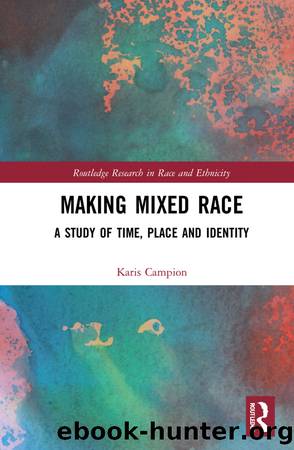Making Mixed Race by Karis Campion

Author:Karis Campion [Campion, Karis]
Language: eng
Format: epub
Tags: Social Science, Sociology, General
ISBN: 9781000482621
Google: yzlJEAAAQBAJ
Publisher: Routledge
Published: 2021-11-23T05:28:42+00:00
In this excerpt mixedness becomes a metaphor for multiculture. The spectre of the postracial looms large beneath Nicholasâ claims that his mixedness might extend him the ability to be devoid of prejudice and connect with all people, regardless of their âcultureâ or âbackgroundâ. The excerpt demonstrates how mixed-race subjects can, at times, occupy the âmoral high groundâ by offering âskills assessments of themselves as âbridge buildersâ or âpeace makersâ in situations of prevalent race thinkingâ (Olumide, 2002: 9). In his account, Nicholas perceives of his mixedness as a âgiftâ which allows him âto see behind the veil of racial ideology [and reject] its premises and its divisive effectsâ (Morning, 2005: 4). Reminiscent of Nicholasâ comments, Robert from the 70s-born cohort felt that being mixed-race made him âmore open minded ⦠about other people and other culturesâ. Another common opinion across the cohorts was that having a mixed-race identity allowed one to enjoy âthe best of both worldsâ.
These positive self-perceptions about mixed-race subjectivities speak back to historical pathologies that represented mixed-race people in a continuous state of conflict due to their supposed competing racial identities (Stonequist, 1937; Christian, 2008). Whilst these (re)framings of mixed-race do challenge harmful stereotypes, they also risk reproducing mixed-race subjects as sites of racial harmony. In doing so, mixed-race can become a smokescreen that obscures our racist realities, if it is persistently framed through âracelessâ language. Further, by tagging mixedness to characteristics or qualities that are supposedly âinherentâ, it becomes re-inscribed with biological meaning and is essentialised once more but this time through problematic notions of âhybrid vigourâ rather than degeneracy (Lewis, 2010: 136). We can see how this can take shape in Patriciaâs (42) comment; âmixedies rule the world because weâre the most beautiful people in the world, we canât help itâ. Patriciaâs perception that mixed-race people possess a particular skill set that can effectively lead the way is in keeping with many social representations of mixed-race in the contemporary moment as; âBritainâs largest ethnic minorityâ,29 âthe twenty-first century familyâ, âattractive [and] disproportionately successfulâ (Aspinall, 2015: 1070, 1073, 1074).
Patriciaâs suggestion that beauty is a naturally occurring trait in mixed-race people is also of particular interest. Again, it speaks to a common mixed-race trope â what Sims (2012: 64) aptly calls, the Biracial Beauty Stereotype. In the contemporary moment, it even appears that the so-called mixed-race aesthetic is beginning to sit âatop the hierarchyâ, overtaking whiteness as the beauty ideal (ibid.: 64). Within contemporary social media culture, the desire to achieve a distinctly Black mixed-race aesthetic is made explicitly clear in a phenomenon termed âblackfishingâ. A term that describes how some white women manipulate their physical features such as skin tone, hair, and lips to align with a Black and particularly mixed-race aesthetic (Dabiri, 2018). Some of the participants seemed to internalise stereotypes about mixedness as a beauty ideal and were privy to reproducing the idea that mixed-race people are inherently attractive (Rockquemore and Arend, 2002; Sims, 2012; Reece, 2016). For participants like 60s-born Olivia, she felt
Download
This site does not store any files on its server. We only index and link to content provided by other sites. Please contact the content providers to delete copyright contents if any and email us, we'll remove relevant links or contents immediately.
Cecilia; Or, Memoirs of an Heiress — Volume 1 by Fanny Burney(32437)
Cecilia; Or, Memoirs of an Heiress — Volume 2 by Fanny Burney(31873)
Cecilia; Or, Memoirs of an Heiress — Volume 3 by Fanny Burney(31857)
The Great Music City by Andrea Baker(31488)
We're Going to Need More Wine by Gabrielle Union(18972)
All the Missing Girls by Megan Miranda(15587)
Pimp by Iceberg Slim(14398)
Bombshells: Glamour Girls of a Lifetime by Sullivan Steve(13977)
Talking to Strangers by Malcolm Gladwell(13229)
Norse Mythology by Gaiman Neil(13211)
Fifty Shades Freed by E L James(13159)
For the Love of Europe by Rick Steves(13054)
Mindhunter: Inside the FBI's Elite Serial Crime Unit by John E. Douglas & Mark Olshaker(9206)
Crazy Rich Asians by Kevin Kwan(9170)
The Lost Art of Listening by Michael P. Nichols(7411)
Enlightenment Now: The Case for Reason, Science, Humanism, and Progress by Steven Pinker(7239)
The Four Agreements by Don Miguel Ruiz(6636)
Bad Blood by John Carreyrou(6557)
Weapons of Math Destruction by Cathy O'Neil(6148)
